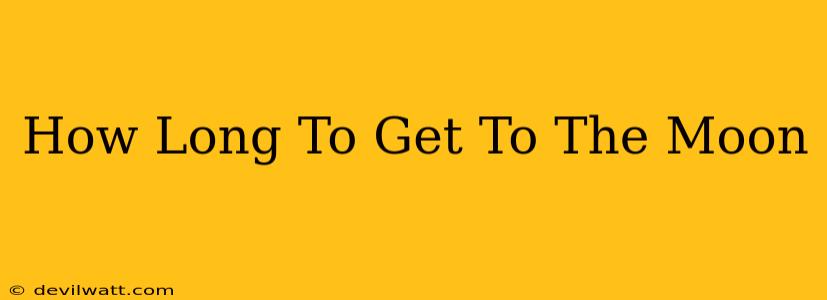The moon. Our celestial neighbor, a captivating orb that has inspired wonder and fueled exploration for millennia. But how long does it actually take to get there? The answer, as with most things in space, isn't straightforward. It depends on several factors.
Factors Affecting Travel Time to the Moon
Several key factors influence the duration of a lunar voyage:
1. The Chosen Trajectory:
- Direct Ascent: This is the most straightforward path, a straight shot to the moon. However, this requires an enormous amount of fuel and is less fuel-efficient.
- Lunar Transfer Orbit: This involves a more complex, fuel-efficient trajectory. The spacecraft enters Earth orbit first, then uses a maneuver to transfer to a trajectory intersecting the moon's orbit. This is the method used by the Apollo missions.
- Free Return Trajectory: This is a special type of lunar transfer orbit designed to ensure the spacecraft will return to Earth even if the main engine fails during the journey.
The type of trajectory significantly impacts travel time. A direct ascent is generally faster, while a lunar transfer orbit, though slower, is more practical and saves fuel.
2. Spacecraft Capabilities:
The speed and power of your spacecraft play a crucial role. A powerful rocket with higher thrust will reach the moon faster than one with lower thrust. The technology used also influences this—more advanced propulsion systems could theoretically shorten travel times considerably.
3. The Specific Mission Objectives:
Some missions might prioritize speed, while others may be more concerned with fuel efficiency. For example, a mission focused on a rapid sample return would likely prioritize speed over other factors, while a long-term lunar base construction mission might prioritize fuel efficiency and a more gradual approach.
Historical Context: How Long Did the Apollo Missions Take?
The Apollo missions, humanity's first successful crewed missions to the moon, provide a historical benchmark. The Apollo 11 mission, the most famous, took approximately three days to reach lunar orbit. This included time spent in Earth orbit before the trans-lunar injection burn. The return trip was similarly timed.
So, What's the Short Answer?
While a theoretical minimum travel time could be shorter with advanced propulsion systems, a typical mission using current technology takes around three to four days to reach the moon. This is a significant achievement, showcasing incredible feats of engineering and human ingenuity. Remember, this is just the travel time; adding time for lunar surface operations and the return journey significantly extends the overall mission duration.
The Future of Lunar Travel:
Ongoing research and development in space propulsion technology could drastically reduce the travel time to the moon. Future missions might leverage advanced propulsion systems, such as ion drives, to achieve faster and more efficient journeys. This could pave the way for more frequent and sustained lunar exploration and, perhaps one day, even colonization.
In conclusion, while the Apollo missions established a benchmark of around three days, the precise duration to reach the moon is variable and depends on multiple interconnected factors. As technology advances, we can anticipate even faster and more efficient journeys to our closest celestial neighbor in the years to come.

